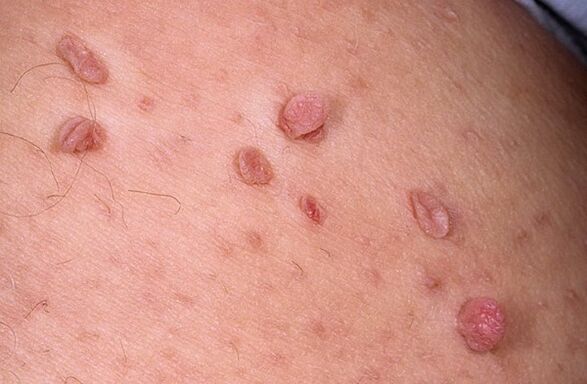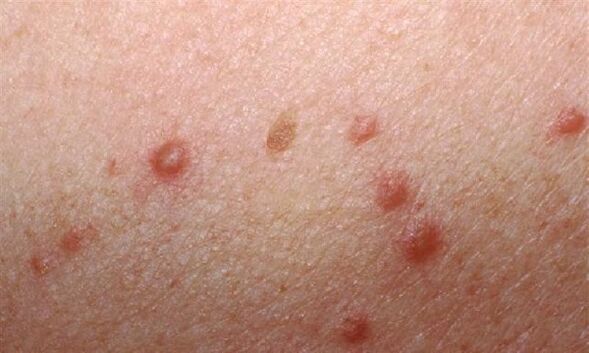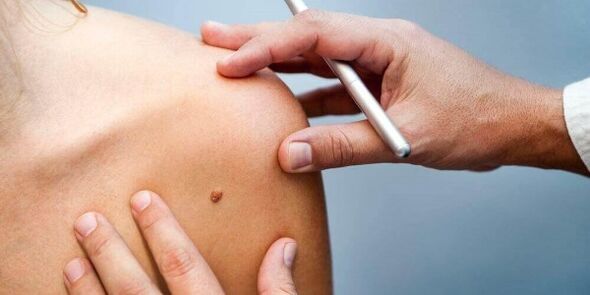In women, the causes of papillomas on the surface of the body are often associated with infection of the body with the papillomatosis virus. There are also congenital formations that are transmitted along with the genetic information of one of the parents.
What are papillomas
Papillomas are benign neoplasms in the female body caused by the pathogenic activity of viral microorganisms from the papillomavirus family. Translated from Latin, it means "papillo - nipple" and "oma - a typical end for all types of tumors. "
Papillomas are formed from the host's own epithelial cells. Externally, it resembles a connecting papilla, which is straight, sharp, round or branched.
A distinctive feature of this type of benign neoplasms is that they can develop in the mucous membranes of the oral cavity, hollow internal organs, inside the nasal cavities, nasal sinuses, and vocal cords.
Initially, the papilloma root is formed by a squamous epithelium that gradually grows over the general skin.

The color of the tumor can vary from flesh to brown and pink. . . Localization of papillomas inside the bladder, intestines, organs of the respiratory system can lead to the development of accompanying diseases and complications.
Types of papillomas in the body in women
Different types of papillomas differ depending on the location, appearance and causes of warts. The following table shows the types of benign neoplasms of this species and their characteristics.
| Papilloma type | Features of the neoplasm |
|---|---|
| Genital warts | They can be located on any part of a woman's body. Externally, they often look like an elongated hanging mole with a brown color. |
| Papilloma vulgaris | The classic form of human papillomatosis virus. Neoplasms are round in shape, attached to the main surface of the body with a thin and short thread. The flesh is colored like the rest of the dermis. |
| Genital warts | The localization of this type of neoplasm is the intimate zone in men and women. Infection occurs as a result of unprotected contact with an infected partner. The main sites of tumors are around the anus, large and small lips in women, and foreskin in men. Household contamination is possible if sanitation and hygiene standards are not followed. |
| Senile warts | Found in older women. Hormonal changes in the body, metabolic diseases, occur as a result of prolonged exposure to the sun's rays. The main danger of this type of papillomas is the high risk of developing malignant neoplasms. |
| Plantar | These types of papillomas are localized only in the plantar part of the foot. Externally, they resemble a small cauliflower head with branched inflorescences. If a woman walks a lot and wears tight shoes, plantar warts can become inflamed, bleed and cause pain. |
Almost all types of papillomas mentioned above are caused by infection with one or another human genotype. The only exceptions are aging warts, which can occur due to age-related changes in the body of older people.
Stages and degrees of papillomas in the body in women
Like any other benign tumor, papilloma develops in several stages in a woman's body.
In this regard, the following stages of wart formation are distinguished:
- Stage 1- uncontrolled division of squamous cell epithelium and the formation of asymptomatic and invisible papilloma root;
- Stage 2- The formation of a wart head 1-1, 5 mm above the general surface of the body can be felt if it is located in the folds of the joints, in the waist area, in the neck or under the armpits. discomfort, itching, skin irritation;
- Stage 3- due to the smallest capillaries connected to the rest of the epithelial tissues, a full-fledged flat, round or elongated neoplasm appears in the form of a root, a leg, a head with a main body and a blood supply;
- Stage 4- the prevalence of similar papillomas resulting from cell division of an existing neoplasm (extensive papillomatosis, dangerous with the possibility of malignant degeneration of a wart).
The stage of skin disease is determined by a dermatologist during the patient's examination. The method of treatment is selected based on the diagnostic results, the type of papilloma and the degree of development.
Papilloma symptoms
Papillomas in the body (the cause of neoplasms in women is due to infection with viral microorganisms) are single or multiple benign tumors that are easy to identify by external signs.
The symptoms of papillomatosis in women are as follows.
- appearance of a small tubercle rising above the general surface of the epithelium;
- wart root growth, growing every week;
- an extraneous neoplasm appears on the body, characterized by a round, branched or conical shape;
- The main localization of papillomas in women is the armpits, inner thighs, neck, skin under the mammary glands, groin, perineum, genitals, back, plantar part of the foot;
- Prolonged exposure to the surface of the wart may cause friction and pain;
- papilloma may have fleshy, yellowish, pink, brown shades, this is the norm;
- Attempts to remove the neoplasm itself do not yield positive results, and the cut wart grows again.

Symptoms such as a sudden change in the color of the wart to dark colors, the onset of an acute inflammatory process, the release of pus or blood fluid, and attacks of pain are not alarming signs that are not typical for papillomatosis. In this case, it is possible that a benign tumor may turn into a cancerous tumor.
Reasons for appearance
Papillomas in the body (causes of the disease in women are related to the patient's lifestyle) are a chronic dermatological pathology that occurs under the influence of the following factors.
Factors of papillomas in the body:
- having an abusive sex life, having close contact with an infected partner without the use of contraceptives;
- sharing towels, cosmetics, soap and other hygiene products with a person with papillomavirus disease;
- sharing indoor slippers and other types of shoes;
- to visit outdoor showers, baths, swimming pools, open steam rooms where papillomavirus virions are present;
- hormonal imbalance in the body due to diseases of the endocrine system;
- entry of a viral infection into an open wound while shaving;
- Infection of the sick child during the passage of the fetus through the birth canal.
In most cases, it is impossible to determine the true cause of warts in the body. The incubation period of papillomavirus after infection varies from a few days to 3 or more years.
Diagnostics
To make an accurate diagnosis of papillomatosis, a woman must undergo a thorough examination of the body and the area of skin where the benign neoplasm is located.
Diagnosis of papillomas occurs in several stages:
- visual examination by a dermatologist;
- donation of venous blood for biochemical examination and identification of papillomavirus virions;
- examination of the deeper epithelial layers of the wart using a dermatoscope;
- capillary blood collection for clinical analysis;
- selection of the papilloma fraction for further histological examination to exclude the oncological nature of the tumor origin;
- morning urine to determine the biochemical composition and general indicators of a woman's health.
Localization of papillomas in the genital area, genitals, and around the anus may require additional examination by a gynecologist and tests for the presence of sexually transmitted infections.
When to see a doctor
The main danger of this type of warts, along with aesthetic defects, is the risk of developing oncology.
It is advisable to consult a dermatologist after the appearance of an external neoplasm.
Early diagnosis and detection of papilloma type allows to organize effective treatment and eliminate the neoplasm with minimal risk of complications.
Prevention of papillomas in the body
Papillomas in the body (the causes of warts in women can be eliminated with effective preventive measures) are benign tumors that can be easily prevented by following the following rules.
For example:
- lead a regular intimate life, have only one sexual partner;
- wear only your own shoes and do not allow others to wear shoes;
- use barrier contraception;
- do not go to the bathroom, toilet, pool, shower and do not put your feet in rubber slippers, do not touch exposed body parts on the surface of walls, door handles, tiles, sunbeds;
- use only your own cosmetics, towels, soaps;
- to undergo a preventive medical examination by a dermatologist at least once a year;
- balance nutrition, sleep at least 8 hours a day, get enough rest to ensure the normal functioning of the immune system.
Not all of the above recommendations provide 100% protection against papillomatous infection, but they do minimize the risk of disease and avoid contact with potential sources of infection.
Methods of treatment of papillomas in the body in women
Papillomatosis is a completely incurable disease. A woman infected with the virus that causes warts carries it for the rest of her life. Modern methods of treatment of the disease can get rid of the consequences of the pathology only in the form of benign neoplasms.
Medications
Traditional medicine does not completely get rid of papillomas, as this type of wart requires removal by chemical, thermal, electrocoagulation, laser or surgical treatment.
Traditional methods
Alternative medicine offers its own alternative ways to get rid of papillomas, regardless of the type and location in the female body. The traditional methods for removing warts are as follows.
Knitting with a rope
It is necessary to wait for the waning phase of the moon. You need to take a piece of black rope and use it to tie a knot, to tie papillomas. This rope is taken to the garden and buried in the ground with the words, "When this rope rots, all my warts will disappear. "After 2-3 weeks, the papilloma will begin to soften and collapse without signs of pain and inflammation.
Special tools
There are special remedies for warts and papillomas, but they do not affect the action and cause relapse. One of these tools is, for example, a special patch.
Such products usually contain natural substances that are somewhat resistant to the virus.
Dog saliva
To get rid of a benign neoplasm using this method, the wart should be spread with an even layer of sour cream. After that, the woman should go to the dog to lick the lactic acid product with her tongue.
After that, the papilloma is sealed with medical adhesive plaster. Saliva cannot be removed from the surface of the neoplasm. The patch can be removed after 1 week. From this point on, the wart will begin to disintegrate.
Bake with strawberries
During the growing season of this plant (from late May to mid-June), cut the strawberry branches daily and clean the warts with poisonous yellow water. The duration of therapy is 10 to 30 days. Care should be taken to ensure that the juice does not get into the mucous membranes of the mouth and eyes.
The effectiveness of the above folk remedies for the removal of papillomas in the body has not been proven by official science. Women who used similar recipes were able to achieve the desired result and respond positively to these treatments.
Other methods
The most effective way to treat papillomas is to remove them completely.
The following methods are used for this:
- chemical combustion- Provides exposure of the surface of warts to aggressive solutions based on acids, potassium or sodium alkalis;
- electrocoagulation- The papilloma is cut and the metal tip is cauterized with a curved tool under electric current (the treatment procedure is performed under local anesthesia);
- cryodestructiona good neoplasm is burned using liquid nitrogen solution (epithelial tissues freeze under the influence of low temperatures and then break down into parts);
- laser coagulation- Excision of the papilloma is carried out using positively charged laser particles, removal of the main body of the wart and cauterization of the root system is provided;
- surgical removal- The traditional and most common method of treatment of dermatological diseases, which consists of removing the wart with a scalpel and then applying sutures.

All of the above methods for the treatment of papillomatosis allow to eliminate benign neoplasms with minimal risk of recurrence.
The average rehabilitation period is 3 to 7 days. The safest methods are laser cutting and electrocoagulation. The most painful and traumatic treatment is traditional surgical removal of the wart.
Possible complications
In the absence of adequate response measures and treatment of papillomatosis in the body, over time, a woman may face the following complications.
Possible complications:
- appearance of similar warts in other parts of the body, which indicates an increase in viral activity;
- the development of warts into a malignant tumor that can be fatal;
- formation of similar neoplasms in the bladder, intestines, larynx, tracheal cavity, which can lead to dysfunction, problems with urination, respiration and digestive function;
- cervical cancer (scientific studies show that 80% of women suffering from this disease are infected with human papillomavirus;
- increase in the size of the wart, the appearance of cosmetic and aesthetic defects;
- damage to the neoplasm and the entry of bacterial infection into the epithelial tissues.
To prevent the formation of papillomas in women, it is necessary to remember the causes of their appearance. This will protect the health of the skin and prevent a decrease in the immune status of the pathogenic activity of papillomavirus. The disease itself is not life-threatening, but its presence can lead to the development of serious complications.















































































